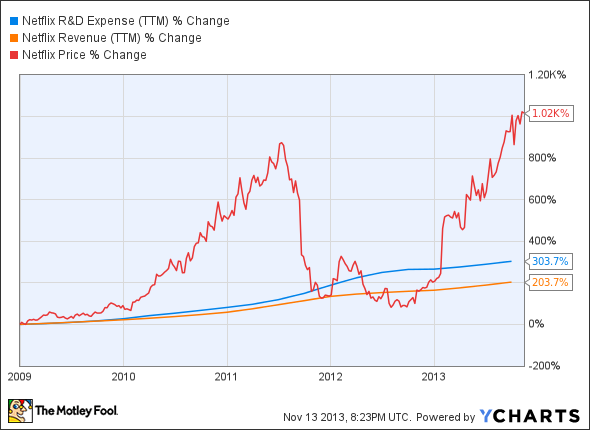Why Won't Every Netflix Box Get the New Design?

The new Netflix interface, designed for high-def and wide-screen TV sets. Image source: Netflix.
Netflix just introduced a unified user interface for a wide range of viewing experiences. The redesigned interface is the payoff for nearly two years of design work, and will make it easier to move from one device to another. Over the next few weeks, you'll receive the exact same Netflix user experience whether you're watching via a Microsoft Xbox 360, a Sony PlayStation 3 or 4, a low-cost Roku box, or a variety of smart TV sets and Blu-ray players.
This is a step toward the tightly unified design philosophy of Apple, where knowing your way around an iPhone also makes you feel at home on an iPad or the iPod Touch. By contrast, the Android mobile platform often catches flak for being fragmented. A Samsung-made Android tablet probably won't look and feel the same as an LG one; tablets and smartphones get wildly different user interfaces; and even the same handset can feel different when the network operator adds its own tweaks.
Apple doesn't play those games, and now Netflix is moving in the same direction. From the digital media veteran's perspective, it couldn't really matter what hardware you're using to watch your movies or TV shows. They should all give you that smooth Netflix feel and nothing else.
But you'll notice a few important and popular boxes missing from the lineup above. If Sony supports two generations of PlayStations, where's the Xbox One? And what happened to Nintendo ?
Netfix isn't just leaving these platforms high and dry for no reason. There are technical reasons for all of these omissions.
Microsoft's Xbox One isn't getting a carbon copy of everyone else's exact experience, because Netflix wants to take advantage of the built-in Kinect system's unique features. It would be a shame not to take advantage of the revamped Kinect's high-powered voice control, for example, and Netflix has enough shared history with Microsoft to ensure a tight integration. So Xbox One gets something different, but you should expect a premium experience rather than a diluted one.
The new Netflix interface is explicitly designed for high-definition, widescreen TV sets. There's plenty of fine detail and text to handle, none of which would look good in less than 720p. The good old Nintendo Wii simply can't handle that kind of pixel-pushing -- it tops out at 480p even with the upgraded composite cables. So this particular design will never make it to the original Wii.
But how about the newer Wii U? This box was made for 1080p displays, and should have no trouble at all handling the demands of the new Netflix design. However, the Wii U already has a bottoms-up 1080p interface for Netflix. In fact, it was the first console to receive the high-definition treatment. Like the unified environment, the Wii U display was built on HTML5 standards rather than console-specific code, and it's likely that the unified version is based on the Wii U work. And like the Xbox One, the Wii U can do things that other consoles can't. Netflix takes advantage of the tablet-style Wii U controller, so this box deserves some personalized TLC.
So there you have it. The original Wii simply can't handle the new Netflix design, while the company just doesn't want to waste the unique benefits of the Wii U and Xbox One consoles.
So it's not a perfect across-the-board unification play, but then Apple didn't roll out the latest version of its iOS platform to older gear like the iPhone 3GS and fourth-generation iPod Touch. Obsolescence happens, folks. On the other end of the spectrum, Netflix doesn't design its own hardware but aims to work with anything you might connect to your big-screen TV. In that situation, it's simply good business to support advanced features from forward-thinking hardware providers.
Netflix has quadrupled its R&D budget over the last five years to support tripling revenues and pave the road toward further gains. And Netflix shareholders aren't exactly complaining about the results.
NFLX R&D expense (TTM) data by YCharts.
What will Netflix's future look like?
The future of television begins now... with an all-out $2.2 trillion media war that pits cable companies against technology giants like Apple and Netflix. So far, the tech team seems to be winning. The Motley Fool's shocking video presentation reveals the secret Steve Jobs took to his grave, and explains why the only real winners are these three lesser-known power players that film your favorite shows. Click here to watch today!
The article Why Won't Every Netflix Box Get the New Design? originally appeared on Fool.com.
Fool contributor Anders Bylund owns shares of Netflix. Check out Anders' bio and holdings or follow him on Twitter, LinkedIn, and Google+. The Motley Fool recommends and owns shares of Apple and Netflix. It also owns shares of Microsoft. Try any of our Foolish newsletter services free for 30 days. We Fools may not all hold the same opinions, but we all believe that considering a diverse range of insights makes us better investors. The Motley Fool has a disclosure policy.
Copyright © 1995 - 2013 The Motley Fool, LLC. All rights reserved. The Motley Fool has a disclosure policy.


